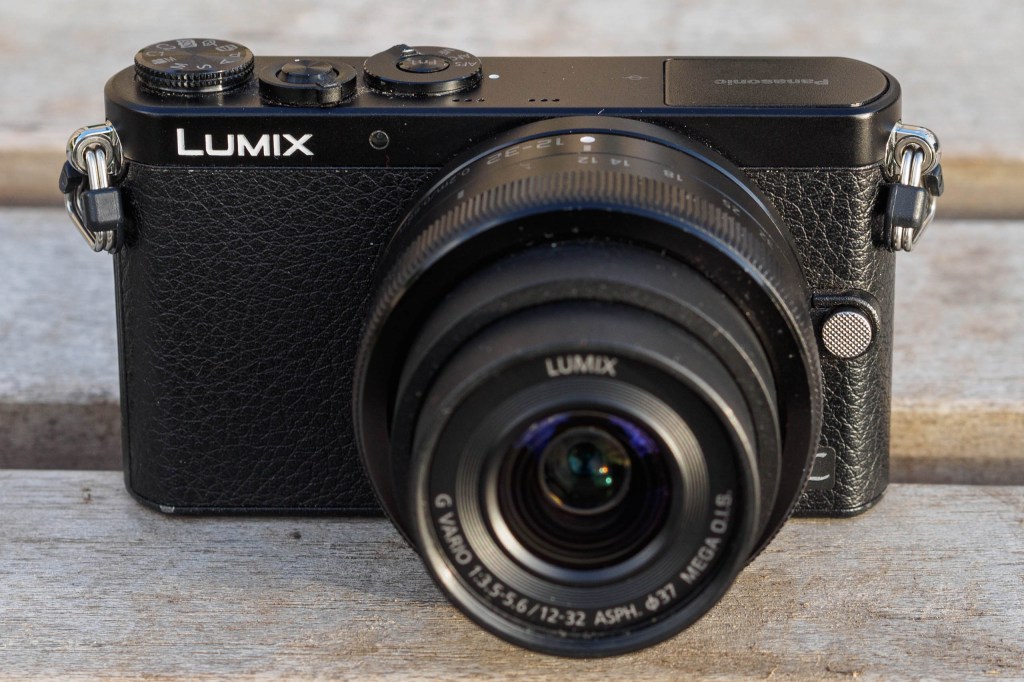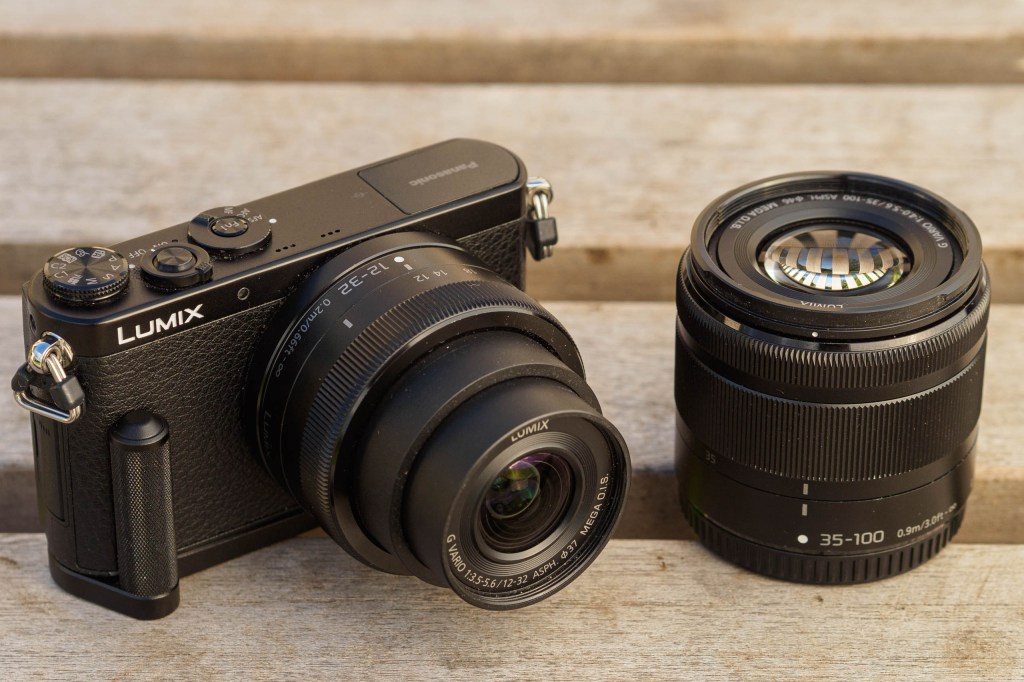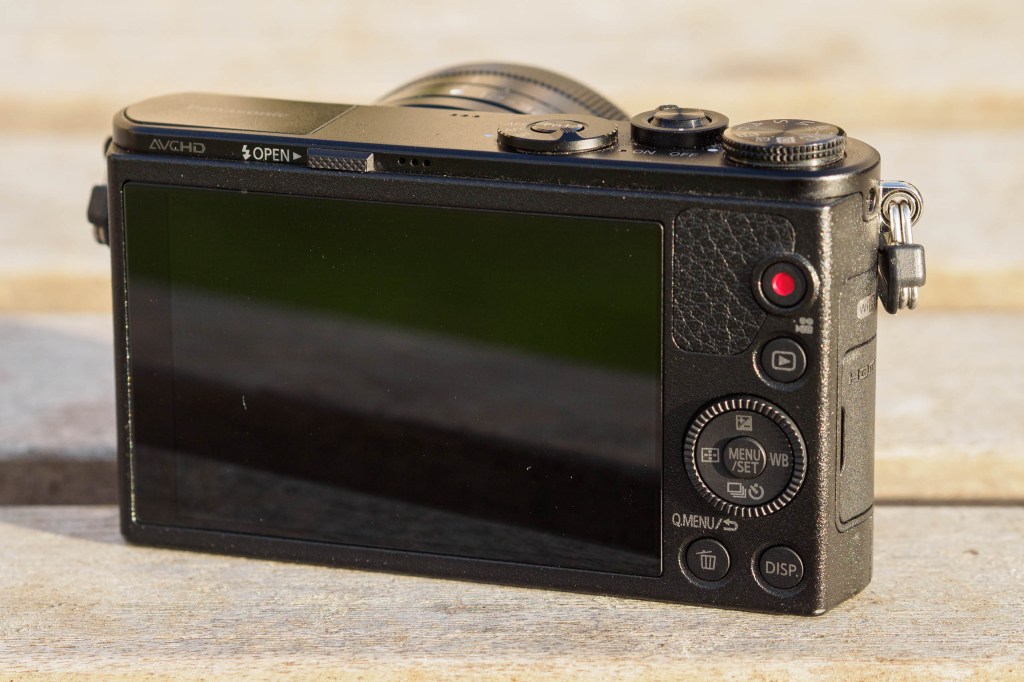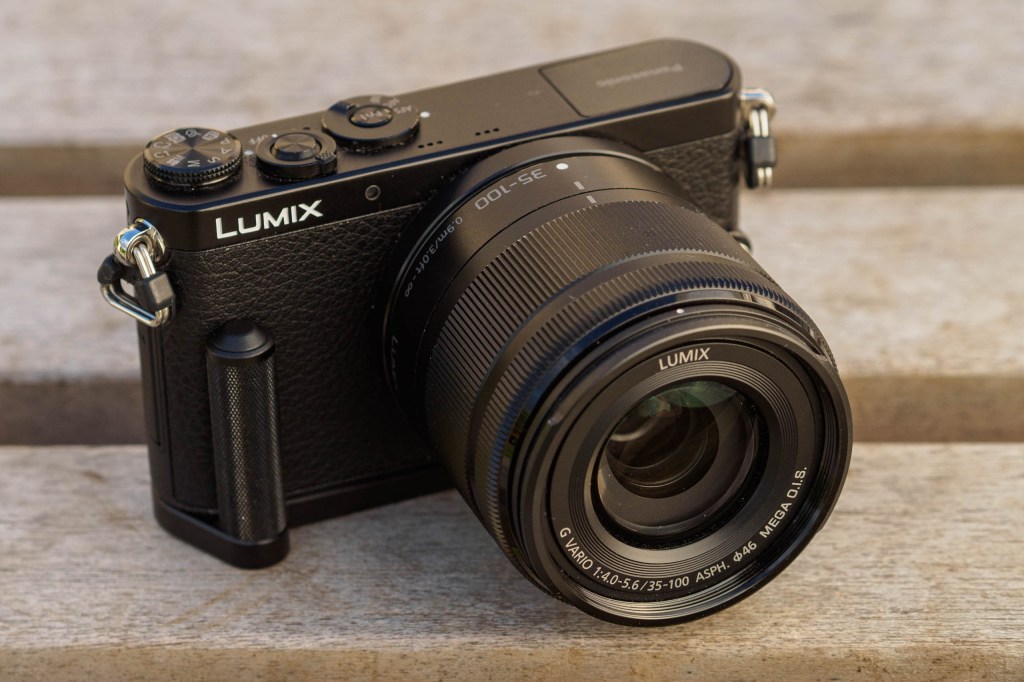The Panasonic Lumix GM1 is still, to this day, one of the smallest mirrorless cameras available. Find out how it performs in this full review.
Panasonic Lumix DMC-GM1 at a glance:
- 16-million-pixel, Four Thirds-sized Live MOS sensor
- Micro Four Thirds lens mount
- 3in, 1.036-million-dot TFT LCD touchscreen
- Lumix G Vario 12-32mm f/3.5-5.6 Asph Mega OIS kit lens
- Sensitivity range of ISO 200-25,600 (125-25,600 auto extended)
- Comprehensive Wi-Fi connectivity
- Street price around £629 with kit lens
Panasonic Lumix DMC-GM1 review – Introduction
While compact cameras score over DSLRs with regard to portability, they can’t compare in terms of image quality. A mix of lightweight, compact design and decent image quality is therefore a balance that camera manufacturers are keen to get right, and it seems that Panasonic has made good progress towards achieving this. The company’s new Lumix DMC-GM1 is a tiny Micro Four Thirds compact system camera with impressive specifications. Essentially, it is the redesigned inner workings of Panasonic’s top-end Lumix DMC-GX7 in a body that fits in the palm of your hand.
The company has identified its target market as 22 to 40-year-old young (and not-so-young) professionals – the kind of people who want a camera they can keep with them all the time to photograph their lifestyle and the things that happen around them. Equally as important is image quality and the ability to share these images on social media. With a 16-million-pixel sensor, interchangeable lenses and comprehensive Wi-Fi functionality, the Panasonic Lumix DMC-GM1 fulfils the criteria exceptionally well.
Panasonic Lumix DMC-GM1 review – Features
Inside the Panasonic Lumix DMC-GM1 is a four thirds Live MOS sensor with a resolution of 16 million pixels. This sensor has dimensions of 17.3x13mm, which is bigger than the 1in sensor found inside the Sony Cyber-shot DSC-RX100 II compact camera, but smaller than the more common APS-C-sized sensor. The GM1 can record images in both JPEG and raw file formats and these images are processed by Panasonic’s own Venus Engine.
The specification of the camera is very similar to the Lumix DMC-GX7. However, the GM1 lacks some of the GX7’s functionality, such as bulb shooting, Near Field Communication and full HD 60i movie recording, although it has the great benefit of being significantly smaller.
With the dimensions of the camera body measuring just 98.5×54.9×30.4mm, it is by far the smallest Micro Four Thirds system camera we have ever seen, and one of the smallest mirrorless cameras.
Panasonic Lumix DMC-GM1 review – Key features
- Flash release button – Sliding a button above the LCD screen allows the built-in flash to pop up.
- Function button – A function button is featured in the middle of this focus-control switch. This can be customised to access a single setting.
- Focus-control switch – This control can be switched to change focus between AF-S, AF-C and MF quickly and easily.
- Movie-record button – A designated movie-record button is featured on the Lumix DMC-GM1, which is located inside the thumb grip.
- Q menu – In playback, this button is used to delete images, but it doubles as the quick menu button in shooting modes.
- Function menu – This small tab can be pressed to show another function menu on the LCD. This can be customised to add different settings.
Announced alongside the GM1 was a brand new lens in the form of the Lumix G Vario 12-32mm f/3.5-5.6 Asph, which has Mega OIS image stabilisation built in. This lens was specifically designed for the GM1 to tie in with the small, lightweight, ‘take anywhere’ ethos behind the camera, and it comes as the standard kit lens.
Weighing 70g and protruding just 24mm from the lens mount when not extended, the lens really is lightweight and compact. Turning the zoom ring extends the barrel and makes it operational. With a Micro Four Thirds crop factor of 2x, the lens is equivalent to 24-64mm on a full-frame camera. Some users might find this short range a little restricting, but for landscapes and portraits it is more than adequate. One slight disadvantage is that the lens does not feature a focus ring, so manual focus can only be altered using on-camera controls.
In terms of connectivity, the GM1 boasts one of the most comprehensive Wi-Fi functionalities of any camera currently available, via the Panasonic Image App (available for both iOS and Android devices). When connected to this app, it is possible to share images or videos directly with a smartphone or tablet – which is fairly standard with most Wi-Fi-enabled cameras – but it goes a step further by enabling full remote wireless shooting via a smart device. In-app manual controls are unrivalled, and allow every setting, including aperture, shutter speed and ISO, to be changed without ever touching the camera.
A pop-up flash is built into the GM1, with a guide number of 4m @ ISO 100. It is reasonably powerful and will be sufficient for casual portraits.
Also featured are 22 different filter effects, along with time-lapse and stop-motion animation modes, so the GM1 ticks all the right boxes for the creative photographer. Importantly, the Panasonic Lumix DMC-GM1 has a built-in intervalometer, which is programmable in-camera (see Time-lapse, for more information on time-lapse mode).

Image: Using the remote shooting function enabled by Wi-Fi allowed me to capture images at angles that would usually be very difficult to achieve
Panasonic Lumix DMC-GM1 review – Time-lapse
 The Time Lapse Shot mode instantly caught my eye when I first flicked through the GM1’s specification list.
The Time Lapse Shot mode instantly caught my eye when I first flicked through the GM1’s specification list.
Most cameras don’t have such a mode, so I was keen to see it in action. Essentially, the time-lapse mode makes use of a built-in intervalometer, which enables the user to shoot a sequence of images at intervals of between 1sec and 99mins 99secs, adjustable in 1sec increments. The number of shots can also be set to between 1 and 9,999.
Once images have been captured, they are stored sequentially in a folder on the camera. These images can then be imported into programs such as Adobe After Effect, Adobe Lightroom, Adobe Premier or QuickTime Pro, and made into a video composition. I set up my time-lapse sequence to take 240 shots at 2sec intervals, which took 8mins. I then compiled the images into a 24fps composition, which gave me 10secs of footage. The final result was a video showing 8mins of time elapsing in just 10secs in real time, made entirely from photos. This is a great tool for making dynamic landscape pictures with moving clouds, or for capturing other active scenes.
Panasonic Lumix DMC-GM1 review – Build and handling
Undoubtedly, the most standout feature of the GM1 is the minuscule size of its body and kit lens. Even including the lens it measures just 98.5×54.9×54.4mm, which is about the same depth as a standard credit card and only just over 13.5mm longer. This incredible feat of engineering is the result of a redesign of many of the camera’s internal parts, including the shutter mechanism and main circuit board.
The GM1’s body is made from magnesium alloy, but is very lightweight. Weighing just 173g body only, and 274g with the battery, kit lens and an SD card, it is also one of the lightest Micro Four Thirds cameras. It fitted comfortably into my coat pocket and I was able to take it with me wherever I went. The GM1 really is a camera you can carry with you all the time.
However, there is a disadvantage that comes with the downscaling of the GM1, which is that it has lost some of the handling qualities offered by larger cameras. For example, there is no substantial grip on the front, and the textured grip on the back is quite small. As a result, when using the camera with one hand I found that it did not feel as secure as I would like, although two-handed operation is OK. An optional handgrip is available, although it costs around £99. This screws into the tripod thread and offers better finger support at the front of the camera, which I suspect will solve this issue.
However, another slight annoyance is that the grip on the rear of the camera is very close to the large 3in touchscreen. On occasion, usually when I was shooting in portrait orientation, my thumb would wander towards the LCD screen as I searched for a grip. This would frequently cause a focus point to be selected in the corner of the frame, which I then needed to correct.
As this camera features very few physical control buttons, it relies primarily on customisable menus and the touchscreen. Thankfully, Panasonic has managed to create a control layout that prevents extensive menu driving and allows settings to be adjusted quickly. A quick menu button located below the D-pad allows users to control ISO, aperture, shutter speed and metering, among other settings, but it can also be customised to add or remove settings. A function menu in the form of a tab on the right of the LCD can be customised for other settings, such as focus peaking, picture style and Wi-Fi.
Due to the high power consumption and small battery size, the GM1 is rated to a lowly 220 shots. For light use it is fine for a couple of days, but heavy users would be wise to buy a back-up battery.
There are four different versions of the GM1 available, all in a ‘modern-vintage’ vein intended to appeal to a more style-conscious audience. These are black, white, silver and tan, all coming with complementary textured leather wrapped around the body. I particularly like the silver body and 1970s retro-vintage style of the tan leather.
Panasonic Lumix DMC-GM1 review – Metering
A 1,728-zone multi-pattern sensing system is used to meter the exposures on the GM1. This is the same hardware we have seen in previous Panasonic G-series cameras, such as the Lumix DMC-G6, GF6 and GX7. The metering performs well in a variety of lighting situations, giving consistent exposures, but in some overcast landscape situations the metering slightly underexposes the images. This can be corrected by tapping the up direction on the D-pad and adjusting the exposure compensation setting by roughly +0.6 EV.
In most other scenes I found that the camera prioritises the midtones to give bright exposures that are rich in detail between shadows and midtones. This is good for users wishing to use images straight out of the camera. The highlights are sometimes lost, but there is rarely any shadow clipping.
The three metering modes available are multi-metering, centre-weighted and spot, all of which return a good result. Spot metering can be linked with a focus point and, thanks to the touchscreen, it is quick and easy to operate.
Panasonic Lumix DMC-GM1 review – Dynamic range

Image: Better dynamic range can be achieved by underexposing the image, then lightening shadows in post-production
When shooting brightly lit landscapes, the GM1 achieves good exposures that have a decent balance between highlight and shadow detail – for most situations there aren’t many areas of burnt-out detail. In more challenging high-contrast scenes the metering captures well-exposed midtones, but often loses some highlight information. When editing in Adobe Camera Raw, however, I noticed that a reasonable amount of information could be brought back in the highlight areas and more still could be recovered by lightening the shadows.
It was rare to see any shadow clipping, so to maximise the dynamic range I adjusted the exposure compensation to -1EV and lightened the shadows and midtones using Adobe Lightroom.
Like most new cameras, the GM1 offers a dynamic-range boosting function known here as iDynamic. This maximises details in the highlight and shadow areas, and can be set to a range of intensities. Even at its strongest setting, it is still much more subtle than much of the competition.
Also included are a high dynamic range creative scene mode and an HDR shooting mode. The latter shoots three separate images and stitches them together in-camera. When shooting handheld, I found that high-contrast edges would often show halos, and ghosting would also appear. This is better suited to use with a tripod.
Panasonic Lumix DMC-GM1 review – Autofocus
Panasonic claims that the GM1’s contrast-detection autofocus, which is used across all its G-series cameras, is fast enough to surpass high-end DSLRs that feature phase-detection AF. In use, the AF certainly didn’t disappoint, as it was usually very speedy in finding focus. Primarily, I used the AF-S focusing mode and even in low-light it took only a fraction of a second. An assist lamp, which can be turned on or off, makes focus speeds in low-light even quicker. Unfortunately, continuous AF does not live up to AF-S and takes a lot longer. Although it is still class-leading, it is noticeably slower and more sluggish.
There are various AF modes on the GM1, including face detection, AF tracking, 23-area, 1-area and pinpoint. Face detection is useful for portraits or groups of people, and locks on fairly quickly. AF tracking can be used to track a specific object in the frame by designating the area using the touchscreen. However, like continuous AF, it was neither very accurate nor quick. In 23-area mode, focus is found using 23 large rectangular focus points, and for most scenes, focus is found with great speed.
In general, though, my two ‘go-to’ AF settings were 1-area and pinpoint. The former allows users to define the size of the focus point using a pinch gesture on the touchscreen, and then allocate the point of focus by touching the required position on the screen. This AF mode is speedy, quick to change and precise. Alternatively, pinpoint puts a small cross hair on the screen that users can place across roughly the inner two thirds of the screen. This brings up a small x3, x4, x5 or x6 enlargement of the particular area for users to check focus. Tapping an on-screen option will also allow users to preview the pinpoint at 100% on the screen. This achieves very accurate and consistent focusing.
The same function described for pinpoint is also offered with manual focusing. Tapping the screen will enlarge a section up to 10x, and can preview it at 100%. Furthermore, the GM1 has focus peaking so fine-tuning manual focus is very easy, especially with the aid of the enlargement functions.
Panasonic Lumix DMC-GM1 review – Noise, resolution and sensitivity
An ISO sensitivity range of 200-25,600 (ISO 125 extended in auto) is featured on the GM1. This is a fairly large sensitivity range, although it is slightly annoying that the minimum native ISO sensitivity is not ISO 100 or even ISO 160. Thankfully, both the raw and JPEG files shot at ISO 200 are very clean, have a high level of detail and show few signs of luminance noise.
In JPEGs, this level of detail preservation continues right up to ISO 800. Thereafter, the in-camera noise reduction starts to gradually break the detail down in a bid to remove noise. Overall, the in-camera noise reduction applied to JPEGs does a good job of controlling noise. In images viewed at A4 size, noise doesn’t start to become an issue until ISO 6400, but if previewed at 100% it is clear to see detail gradually become smudged.
Significant detail is lost at ISO 12,800 and at ISO 25,600. Luminance noise is prominent even when previewed at A4 size. The maximum ISO 25,600 had obvious colour noise, and readout lines from the sensor are visible. Obviously, this high sensitivity setting is best avoided.
For JPEGs, I think ISO 800 offers a nice balance between image quality and speed. I found that when processing raw images in Adobe Lightroom, I was able to push the sensitivity 1EV further and achieve a result on a par with the JPEGs.

These images show 72ppi (100% on a computer screen) sections of images of a resolution chart, captured using the 12-32mm lens set to 34mm and f/5.6 . We show the section of the resolution chart where the camera starts to fail to reproduce the lines separately. The higher the number visible in these images, the better the camera’s detail resolution is at the specified sensitivity setting.
Panasonic Lumix DMC-GM1 review – White balance and colour

Image: Using Wi-Fi, images can be sent from the camera to a smart device and quickly adjusted using Adobe Photoshop Touch
Inside the GM1’s white balance menu is a wealth of different options. These include auto (AWB), daylight, cloudy, shadow, incandescent, flash, white set 1 and 2, and a custom colour temperature setting. The custom setting is very good and was the one I opted for the most. It allows users to view the scene in real time and adjust the colour temperature between 2,500K and 10,000K in 100K steps. This is a very precise and easy way to adjust the white balance.
By simply tapping down on the D-pad while in a white balance setting, the blue/yellow and magenta/green bias can be adjusted, which is very useful. I found that in AWB the tungsten white balance was often too cold, so nudging towards the yellow axis added a welcome warmth to the image.
Overall, colour rendition is good, although in some scenes colours appear a bit flat. Thankfully, under the photostyle option, it is easy to boost the image saturation to bring back some of the punch. A host of other picture styles can also be applied from this menu, including portrait, vivid and monochrome.

Image: In its standard mode, colours look natural, although slightly muted
The scene modes have a variety of different options, including cross-process, silky monochrome and dynamic monochrome.
Panasonic Lumix DMC-GM1 review – Viewfinder, live view, LCD and video
Almost all the camera’s rear is taken up by a large 3in TFT LCD screen. This features touchscreen functionality and boasts a resolution of 1.036 million dots. That is a decent resolution and is on a par with, or better than, most cameras recently released. The refresh rate of the screen is good and in use it is very responsive. In bright conditions reflections did not present a problem, and the viewing angle is as good as it can get.
The responsiveness of the touchscreen is faultless, registering every intentional touch without issue. Swipe and pinch gestures also work well. Using a pinch gesture to zoom or to enlarge a focus point, or a swipe gesture to scroll through pictures, is intuitive and makes the camera very usable.
Many of the screen’s settings can be changed and adjusted inside the menus, including brightness, contrast, saturation, and red/blue bias. However, the default settings are really good and I never felt the need to change them, although it is of course nice to have the option.
Video can be captured at a resolution of 1920×1080 pixels at either 50i, 25p or 24p, as well as a lower-resolution setting of 1280×720 pixels at 50p. The stereo sound can be adjusted to four different levels and there is an option to minimise the muffled audio caused by wind passing over the microphone. This setting can be set to auto, turned off, or varied in intensity.
Panasonic Lumix DMC-GM1 review – The competition

Being the smallest Micro Four Thirds camera available, it is hard to find a direct competitor for the Panasonic Lumix DMC-GM1 as there is no camera with the same balance of specification and pocket-ability. However, for the user looking for a large sensor inside something small and lightweight, the Sony Cyber-shot RX100 II has a 1in sensor with a resolution of 20.2 million pixels. Coupling this with a 28-100mm f/1.8-f/4.9 lens, the RX100 II is capable of producing fantastic images, but only with a fixed lens.
Another potential competitor for the GM1 is Panasonic’s own Lumix DMC-GX7. It has near-identical specification and functionality, but benefits from an EVF, bulb-mode shooting and 1080 60i video recording.
Panasonic Lumix DMC-GM1 review – Our verdict

Image: The Panasonic Lumix DMC-GM1 is perfect for documenting everyday life as it can be carried with you everywhere
With its stylish design and compact body, it is fair to say that the Panasonic Lumix DMC-GM1 will go down well with its target audience – the style-conscious young professional. However, this camera is much more than something that just looks good: it offers great potential as a ‘take anywhere’ camera thanks to the ultra-compact design.
Coupling the good image quality with the ability to use some fantastic lenses, the GM1 is something special. The Wi-Fi functionality is class-leading, allowing users to shoot and share their images quickly and easily. The dynamic range is as expected of a G-series camera and the noise performance enables impressive results right up to ISO 3200. Images up to ISO 800 are highly detailed with little noise. My only complaint is the short 220-shot battery life and the slight shortcomings in the camera’s handling, by which I mean the small thumb grip and the lack of a grip at the front. On the plus side, these issues can be remedied with the purchase of a spare battery and additional handgrip.
Overall, for users looking for a camera that is lightweight, pocketable and capable of producing great images, the Lumix DMC-GM1 fits the bill.

Panasonic Lumix GM1 Menus and screens:
Follow AP on Facebook, Twitter, Instagram, YouTube and TikTok.
Initial Hands-on review – Introduction
When you hold the Panasonic Lumix DMC-GM1 in the palm of your hand, you realise what a remarkable feat of electronic engineering it really is. To all intents and purposes, the new micro four thirds system camera is a Panasonic Lumix DMC-GX7 in a lighter and much smaller body. In fact, the body is so tiny that Panasonic has boasted that in width and height it is around the same size as a playing card. This makes the camera about the same size as the Sony Cyber-shot DSC-RX100, but with the option to change the lens sitting in front of the 16-million-pixel, micro four thirds-sized Live MOS sensor.
The pocketable GM1 is designed for those who like to carry a high-quality camera around every day, with Panasonic identifying its target market as 20-to-44-year-old city dwellers with full-time jobs, who like to keep up-to-date with current technology and trends. Panasonic’s profiling sees these users as wanting a camera to photograph their travels, family, friends and events – basically, it is as much a lifestyle accessory as it is a camera. However, the camera is a long way from being just a gimmick or gadget, and it offers much for the enthusiast and professional photographer.
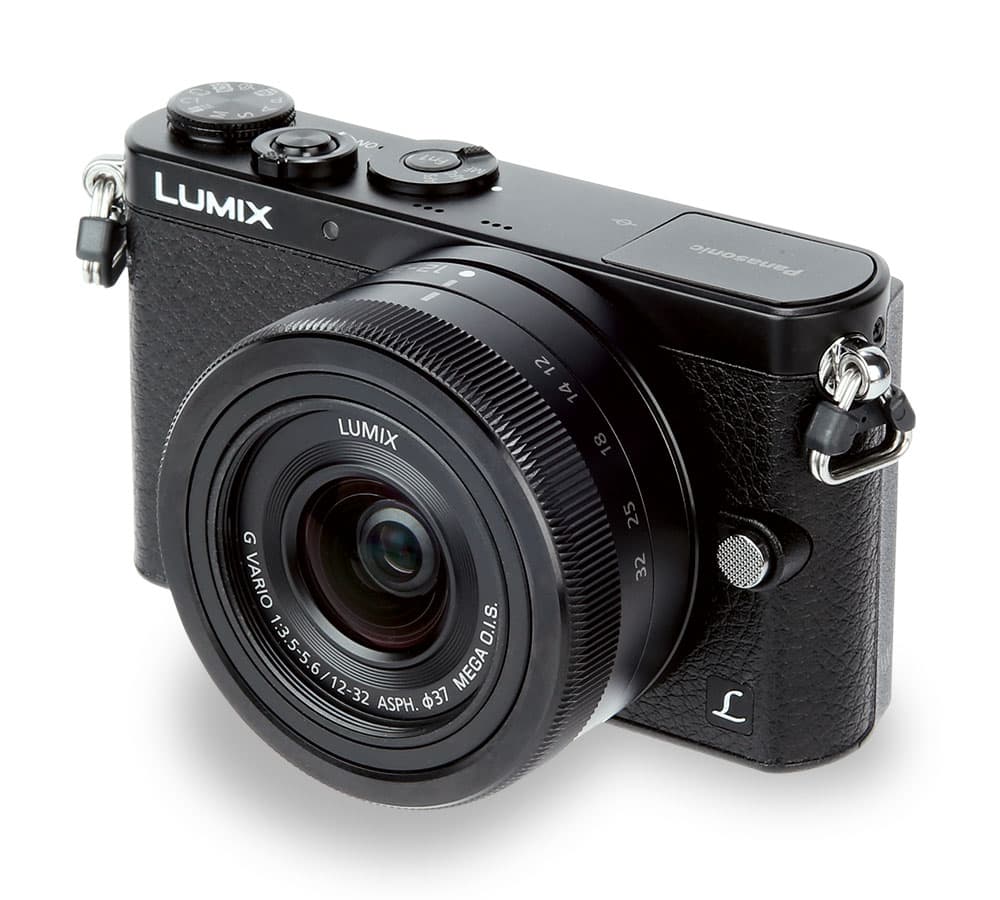
Panasonic Lumix DMC-GM1
Panasonic Lumix DMC-GM1 – Features
The GM1 has a 16-million-pixel sensor with no anti-aliasing filter, and a maximum sensitivity of ISO 25,600. The processor is the same as that found in the GX7, which helps the camera drive and focus the lens with a 240fps refresh rate. This affords the GM1 an extremely fast AF acquisition speed of just 0.06secs, although obviously only when shooting with certain compatible lenses under certain lighting conditions. Still, this is a very impressive speed.
At a shooting rate of 4fps it is possible to use continuous AF tracking, and in single-shot mode the shooting rate can be increased to 5fps. Even more impressive is the maximum shutter speed of 1/16,000sec, which is achieved via a virtual electronic shutter. Slower speeds use an electronic shutter to start the exposure, but end it with a traditional mechanical shutter. The electronic shutter is also used in silent mode, which switches off all the camera’s ‘beeps’. A new type of shutter has been used to make this possible, but more on this in Build and handling.
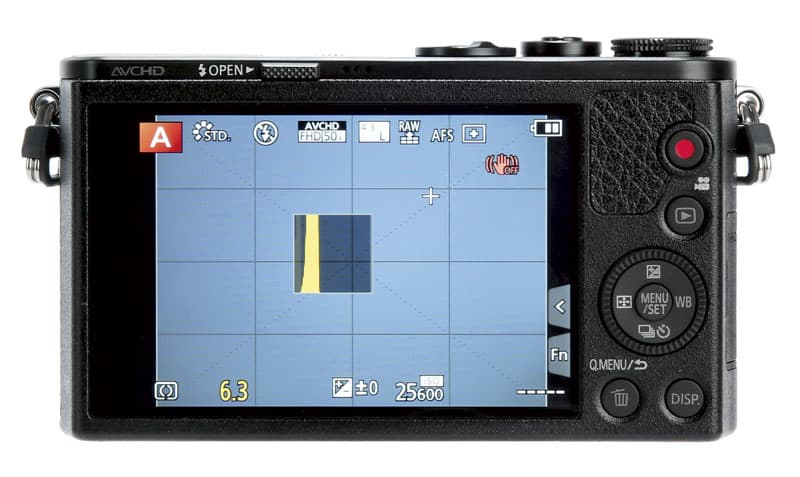
Panasonic Lumix GM1 back
Despite its size, the GM1 has a 3in, 1.036-million-dot touchscreen, with focus peaking to aid manual focus. The screen can also be used for the clear retouch mode that allows small imperfections to be removed from images by touching them on the camera’s screen, much like using the Healing Brush in Photoshop. Wi-Fi connectivity is built into the camera, allowing image viewing and remote shooting from a smartphone or tablet via the Panasonic app for Android or iOS. However, Near Field Communication (NFC) hasn’t been included, as it simply couldn’t be fitted in to the small body of the camera.
The specification of the GM1 is impressive, given its size and £629 price. The AF appears to be as fast in the GM1 as it is in the GX7, and the rear screen is bright and clear. Overall, there is little not to like, although I have no doubt there will be a few who bemoan the lack of a hotshoe for the use of a flash or even an electronic viewfinder. Given the target market for the GM1, I doubt these two features will be widely missed.
Panasonic Lumix DMC-GM1 – Build and handling
By far the biggest selling point of the GM1 will be the size of its body. The engineers at Panasonic have worked hard to make the body as small as possible, but without compromising on any of the features or functionality that we have come to expect from the micro four thirds G-series cameras.
The body is made from magnesium alloy, so it is as strong as it is stylish. The components around the sensor have been reduced by 30%, while the frame around the sensor is 40% smaller. Even more impressive is the fact that the shutter unit has been reduced by 80%. This reduction has been achieved by replacing the conventional mechanical shutter with a single sprung shutter activated by a small stepping motor. This is why the first ‘shutter curtain’ is now electronic, before the exposure is ended with the mechanical shutter.
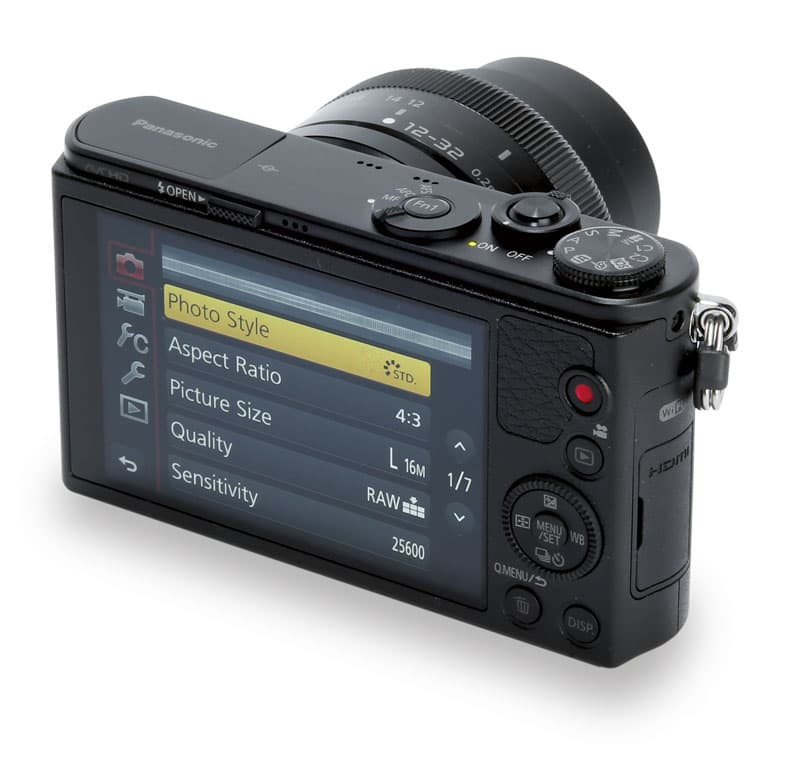
Panasonic Lumix GM1 back
The main circuit board is also 30% smaller, and rather than being the entire width of the camera it forms a ‘U’ shape around the lens mount and sensor, making full use of the area inside the camera body. It is extremely impressive how few compromises have been made.
The button layout is simple and straightforward. Given the size of the camera and screen, it is perhaps no surprise that there are few direct control or function buttons on the body, but there are enough to allow the quick change of settings, particularly when combining these with the touchscreen. I did find that the shutter button was a little small, but it is still usable. As a replacement, I would consider adding a ProDot stick-on shutter button from Custom SLR (www.customslr.com/products/prodot) to make it a little more tactile. The rear buttons are all of a reasonable size, and it feels a lot like using a compact camera. Those wanting a little more purchase on the camera, which can be a little awkward to hold at some angles, will no doubt benefit from the optional handgrip accessory that is attached via the tripod screw mount.
Panasonic Lumix DMC-GM1 – Lenses
Accompanying the new GM1 is the Lumix Vario 12-32mm f/3.5-5.6 Asph kit lens. This is the equivalent of a 24-64mm lens on a full-frame camera, and it has a collapsing design to make it as small as possible when not in use. It is the ideal everyday lens for the camera, although a Leica DG Summilux 15mm f/1.7 Asph wide-angle is planned for release, along with an unspecified 35-100mm lens. These optics are designed to be smaller than the standard micro four thirds lenses, although they will be compatible with all micro four thirds cameras. All existing lenses can be used with the GM1.
Panasonic Lumix DMC-GM1 – First impressions
There have been a number of exciting camera releases recently, and the Panasonic Lumix DMC-GM1 continues that trend. With much of the recent hype concentrating on the Sony Alpha 7 models, the GM1 is an interesting proposition. It may not have a full-frame sensor or an EVF, but it is less than half the price of the Sony cameras and is substantially smaller. There are few high-quality cameras that a photographer can keep on their person at all times, and the GM1 is a welcome addition to the list.
The Panasonic Lumix DMC-GM1 was released in middle to end of November 2013, price £629 with 12-32mm f/3.5-5.6 kit lens.
Follow AP on Facebook, Twitter, Instagram, YouTube and TikTok.


